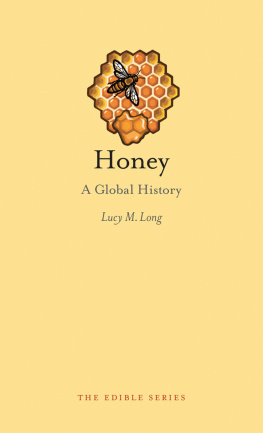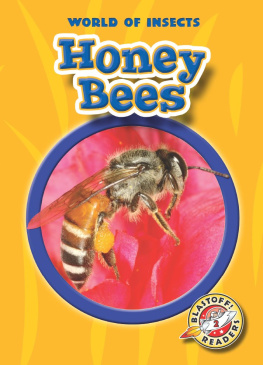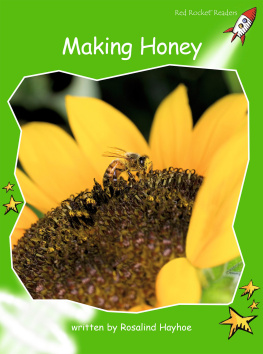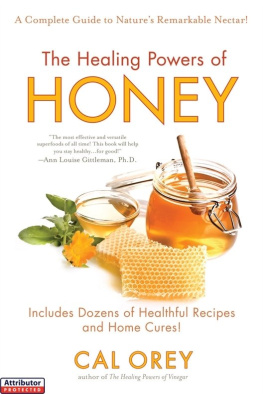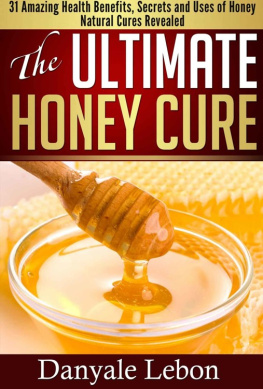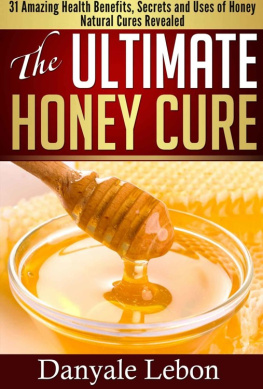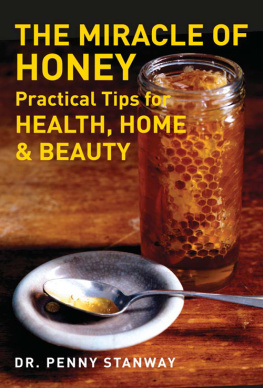HONEY

Edible
Series Editor: Andrew F. Smith
EDIBLE is a revolutionary series of books dedicated to food and drink that explores the rich history of cuisine. Each book reveals the global history and culture of one type of food or beverage.
Already published
Apple Erika Janik Banana Lorna Piatti-Farnell
Barbecue Jonathan Deutsch and Megan J. Elias
Beef Lorna Piatti-Farnell Beer Gavin D. Smith
Brandy Becky Sue Epstein Bread William Rubel
Cake Nicola Humble Caviar Nichola Fletcher
Champagne Becky Sue Epstein Cheese Andrew Dalby
Chillies Heather Arndt Anderson Chocolate Sarah Moss
and Alexander Badenoch Cocktails Joseph M. Carlin
Curry Colleen Taylor Sen Dates Nawal Nasrallah
Doughnut Heather Delancey Hunwick Dumplings Barbara Gallani
Edible Flowers Constance L. Kirker and Mary Newman
Eggs Diane Toops Fats Michelle Phillipov Figs David C. Sutton
Game Paula Young Lee Gin Lesley Jacobs Solmonson
Hamburger Andrew F. Smith Herbs Gary Allen Honey Lucy M. Long
Hot Dog Bruce Kraig Ice Cream Laura B. Weiss Lamb Brian Yarvin
Lemon Toby Sonneman Lobster Elisabeth Townsend
Melon Sylvia Lovegren Milk Hannah Velten Moonshine Kevin R. Kosar
Mushroom Cynthia D. Bertelsen Nuts Ken Albala Offal Nina Edwards
Olive Fabrizia Lanza Onions and Garlic Martha Jay
Oranges Clarissa Hyman Pancake Ken Albala
Pasta and Noodles Kantha Shelke Pie Janet Clarkson
Pineapple Kaori O Connor Pizza Carol Helstosky
Pomegranate Damien Stone Pork Katharine M. Rogers
Potato Andrew F. Smith Pudding Jeri Quinzio Rice Renee Marton
Rum Richard Foss Salad Judith Weinraub Salmon Nicolaas Mink
Sandwich Bee Wilson Sauces Maryann Tebben Sausage Gary Allen
Seaweed Kaori OConnor Soup Janet Clarkson
Spices Fred Czarra Sugar Andrew F. Smith Tea Helen Saberi
Tequila Ian Williams Truffle Zachary Nowak
Vodka Patricia Herlihy Water Ian Miller
Whiskey Kevin R. Kosar Wine Marc Millon
Honey
A Global History
Lucy M. Long
REAKTION BOOKS
Published by Reaktion Books Ltd
Unit 32, Waterside
4448 Wharf Road
London N1 7UX, UK
www.reaktionbooks.co.uk
First published 2017
Copyright Lucy M. Long 2017
All rights reserved
No part of this publication may be reproduced, stored in a retrieval system, or transmitted, in any form or by any means, electronic, mechanical, photocopying, recording or otherwise, without the prior permission of the publishers
Page references in the Photo Acknowledgements and
Index match the printed edition of this book.
Printed and bound in China by 1010 Printing International Ltd
A catalogue record for this book is available from the British Library
eISBN: 9781780237800
Contents

Introduction

Stickiness, sweetness and bees. Those are the associations with honey that many of us have. My own memories of honey are tied to childhood visits to my fathers family in the Appalachian mountains of western North Carolina. We always stopped at one of the many makeshift roadside stands to purchase jars of honey. Local and home processed, the raw honey in the jars usually contained pieces of floating honeycomb, which we treated like chewing gum. Sourwood and clover tended to be the most common flavours, but nectars from locust, linn and poplar trees and numerous wildflowers also flavoured the local honeys. Everyone seemed to keep bees; wooden hives were a frequent part of the landscape, and a jar of honey was on every kitchen table. The honey was dribbled over warm cornbread or biscuits fresh out of the oven. We would eat with our fingers, our hands dripping with melted butter and honey sticky fingers were an expected result, along with a full and satisfied tummy.
As I grew older and was fortunate to travel the world, I found honey to be a constant usually as a sweetener or a flavouring for pastries and other foods. It was also stirred into drinks, hot tea usually, and used to soothe sore throats. Honeys ubiquity, though, almost disguises its significance. It has played a major role in the nourishment and health of humankind from ancient civilizations up to the present, not only as a food, but as a medicine, topical ointment, preservative and an energizer; it has even been used as an embalming fluid and adhesive.
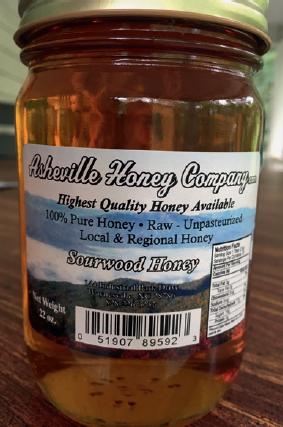
| Sourwood honey from the mountains of western North Carolina. |
Historically, honey featured in mythology and religious rituals. Considered a food for the gods, it also played a role in some creation stories. Even today, honey features in language, the arts and popular culture. Its sweetness is associated with romance and affection, and the word honey is often used as a term of endearment. It can also refer to truthful and honest speech, and when associated with food, health or cosmetic products, it tends to represent the best of the natural world.
What is honey, though? According to the Merriam-Webster Dictionary, it is a sweet viscid material elaborated out of the nectar of flowers in the honey sac of various bees. It is not a very appetizing description, nor is the process of creating honey very appealing. Bees collect nectar from flowering plants, swallowing it through their straw-like probosces into a special sac, called a honey stomach, where an enzyme is added that causes inversion, transforming the complex sugars of the nectar into simpler ones. That mixture is then regurgitated to other bees in the hive, who also consume it and then regurgitate it again into honeycomb cells. The bees then rapidly flap their wings, fanning the honeycombs and causing the water in the nectar to evaporate and turning it into honey, which is stored to be used as food for the bees. Considering the size of honeybees, it comes as no surprise that a lone bee over its entire lifetime can make only one-twelfth of a teaspoon of honey. The honey that we consume represents the cooperative effort of hundreds, if not thousands, of bees.
The history of honey is intertwined with the history of bees of mankinds beliefs about them, of attempts to find and gather honey from them, and the strategies utilized to contain and cultivate bees so as to control honey production and harvest it more easily. Bees themselves have been the subject of literature, art, music and other imaginative pursuits, as well as the focus of an occupation and hobby one of the earliest cave paintings, dating from 8000 BC, shows bees surrounding human figures gathering honey, and some of the first printed works in the Western world were about beekeeping.
Honey is a complicated subject. Bees manufacture other products along with honey, and these are frequently found literally mixed in with the honey or associated with it: bee pollen (pellets of pollen formed by bees in the hive and used as a source of protein), propolis (a resinous substance collected by bees from trees and turned into glue for their hives), royal jelly (a bee secretion used to feed the larvae and the queen bee) and wax from the honeycomb. These have had a variety of uses throughout history, including culinary ones.

